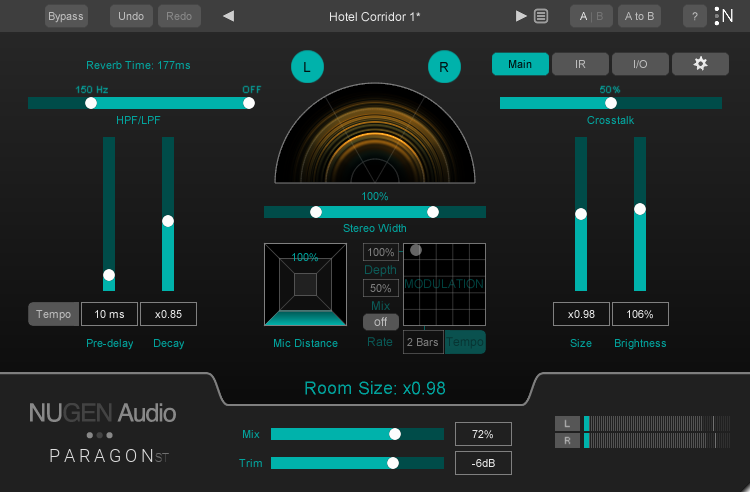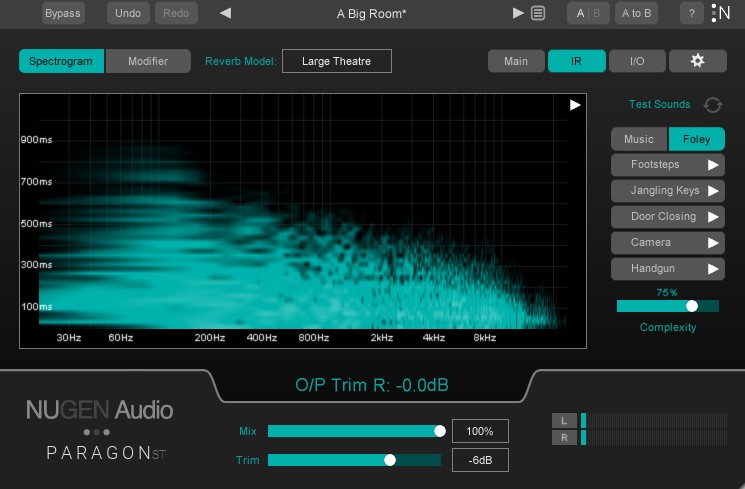
NUGEN Audio Paragon ST Review
By Nate [KVR] on
NUGEN Audio's Paragon ST is the stereo version of their flagship surround reverb, designed for music producers not requiring the full suite of features available in its big brother and with a much lower price tag to boot. New features such as modulation and stereo width control have also been added to the ST version.
Best of both worlds
Most reverbs you would find in a DAW these days typically fit into one of two categories. Algorithmic reverbs, which utilize complex combinations of delay lines, loops, and filters to simulate an environment, and convolution reverbs, which utilize impulse responses – in layman's terms, essentially a snapshot of a physical space or environment. Whilst Paragon ST is a true convolution reverb, it manages to shed many of the pitfalls of convolution reverbs such as the oversized IR libraries, increased system load and general inflexibility when tweaking parameters. Nugen have managed to do this through a clever resynthesis process, essentially using a FFT (Fast Fourier Transform) to measure spectral content and recreate it as data rather than audio files. The result is a small palette of resynthesized impulse responses with a huge amount of flexibility with regards to tonality, character, and length of the reverbs.
Control freak
Paragon ST is chock full of features and control. The main page provides access to typical reverb controls including filters, pre-delay, size, and decay. You'll also have access to stereo width controls and modulation from here, as well as the ability to dial in mic distance, crosstalk, and the brightness of the selected impulse response.
Flick over to the IR page and you'll be greeted with the base IR selection as well as comprehensive tools for shaping the IR both in tonality via the amplitude editor or via frequency specific decay controls. A complexity slider adjusts the detail of the resynthesis algorithm. A fantastic feature here is the bank of samples, split into foley and musical, which can be triggered whilst editing to preview changes without needing to pass audio through the plugin.
Paragon ST also features a comprehensive I/O section for both pre and post trim, tempo synced pre-delays and additional decay and crosstalk controls, all of which can be set independently for the left and right channels.
The Verdict
Paragon ST excels at what you would expect a convolution reverb to excel at, namely accurately portraying a physical space. The presets covering small ambiences and spaces such as car interiors and such are particularly useful as they are typically hard to achieve with the use of algorithmic reverbs. It can however be pushed into completely new sound design territory given the amount of control you have over the IRs. Effects akin to amp and speaker sims can be achieved by drastically reducing decays and sizes beyond their intended limits. Vice versa they can be extended to create lengthy modulating reverb tails. Paragon ST is a unique reverb with a unique sound and would make a welcome addition to many a producer's reverb arsenal.
About the author
Nate Raubenheimer is a member of the KVR team and an accomplished producer, audio engineer and self-proclaimed gear junkie with a career spanning over twenty years. Producing under his Protoculture alias (amongst others) his production and remix credits include the likes of Armin van Buuren, Paul Oakenfold, Bryan Adams, Ferry Corsten, and Johnny Clegg to name but a few. A sound designer for his own Marula Music label, his work includes commissioned patches for various UVI instruments, Brainworx, Knif Audio and more. He is a regular guest lecturer at Sonic Academy.
Read More Review

Discussion
Please log in to join the discussion



